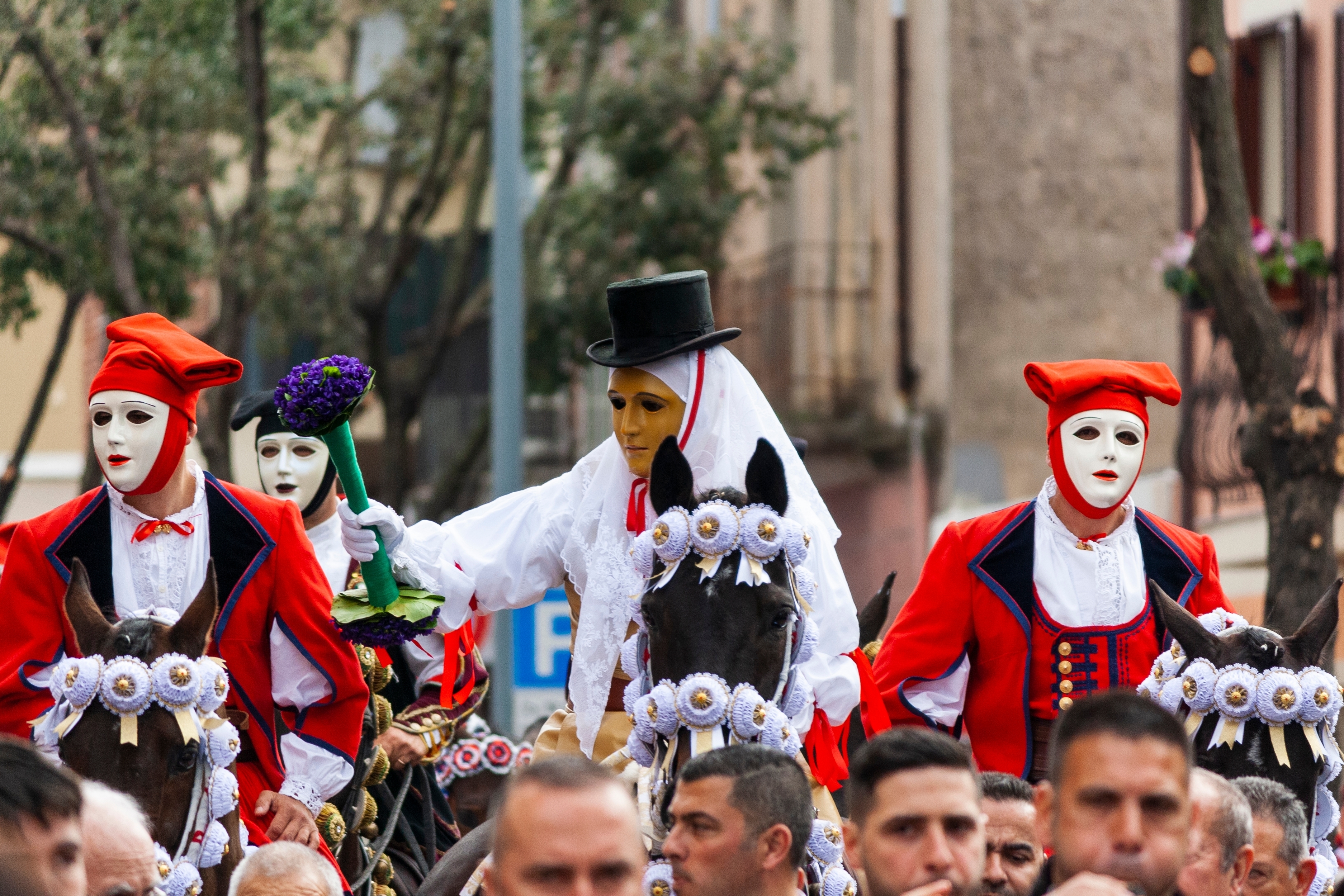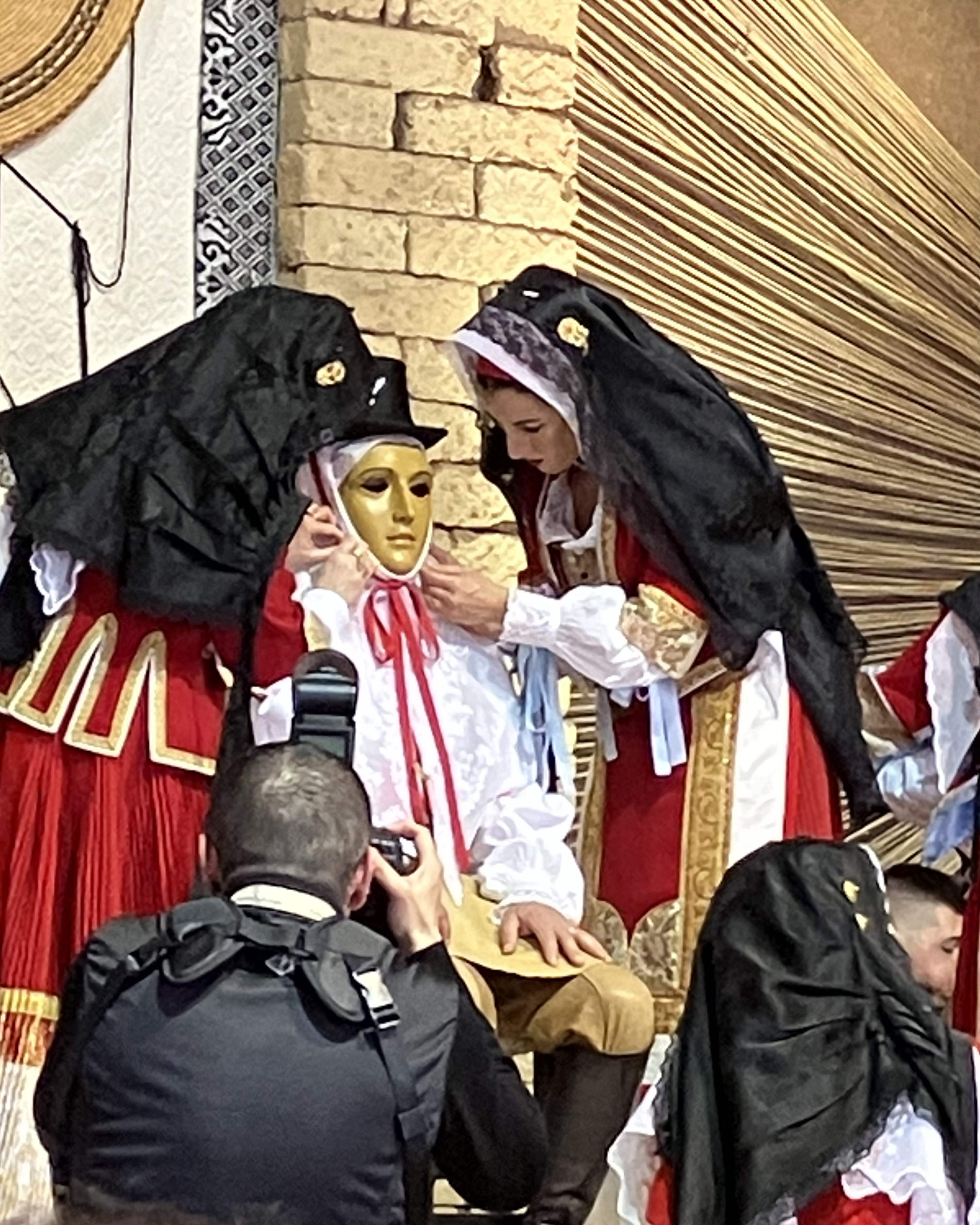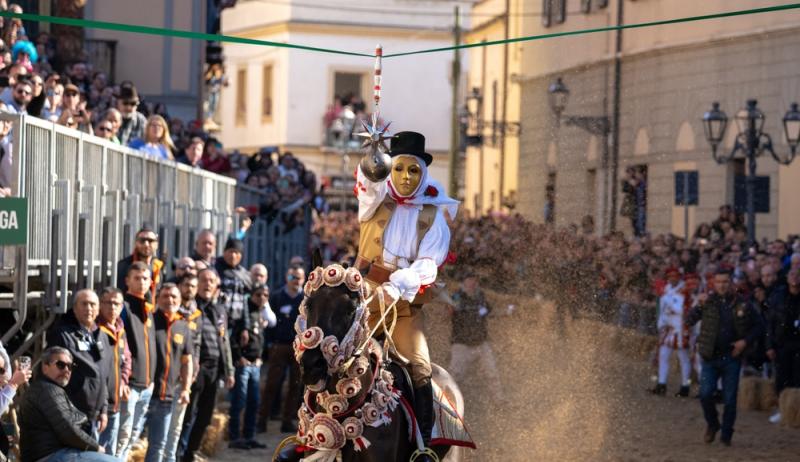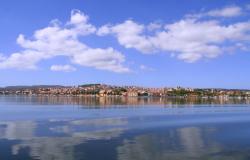Genderless masked demigods in 16th-century ceremonial garb, terrifying feats of horsemanship, bystanders munching on sugary fried treats, and one coveted tiny tin star: This is sa Sartiglia di Oristano, the island of Sardinia’s strangest and most exuberant event of Carnevale season.
For more than six centuries, the town of Oristano — located in the central-western part of Sardinia — has staged a heart-thumping two days of jousting, parades and show-stopping horsemanship.
With a blend of medieval Spanish, Christian and pagan influences, sa Sartiglia and its preeminent race Corsa alla Stella (“race to the star”) go back to at least the 11th century, according to today’s organizers. Believed to have started as a military game to train soldiers during the Crusades, the oldest official mention of sa Sartiglia was recorded in Oristano’s archives in the 1547 or 1548, and refers to the event of 1546, when the race was held in honor of King Charles V.
Coinciding with the Lenten calendar, the festival takes place annually on Carnival Sunday and Shrove Tuesday (Fat Tuesday or martedì grasso) — for 2024, that’s February 11 and 13. For these two days, the town transforms from a modern small city of 30,000 into a mystical medieval dreamscape, drawing tens of thousands for events believed to be among the last ring races held in Europe.
The secretive su Componidori
Androgynous, supernatural and masked deities known as the su Componidori are the figures at the forefront of the Sartiglia. These figures serve as head knights of their respective races on Sunday and Tuesday. Local superstition speaks to their mystical power and intrigue: If the anointed head knight should fall off his horse at any point during his race day, it’s said that the good fortune of the entire region may be in jeopardy.
The shrouded-in-mystery duo is selected by the brotherhoods of Il Gremio dei Contadini (guild of farmers) and Il Gremio dei Falegnami (carpenters) following an early-February Catholic mass called the Candlemas. The farmers are in charge of running sa Sartiglia on Sunday, while the woodworkers’ guild oversees the events on Tuesday. Members of the organizations are sworn to secrecy and must keep the names of the year’s Componidori under wraps until days before the festival begins.
Throughout the festival, there’s a full roster of fun things to do and see, but it’s the equestrian joust in Oristano’s old city center that packs the biggest punch.
First murmurings of sa Sartiglia

Sa Sartiglia kicks off in the early morning hours with a town crier on horseback escorted by drummers and trumpeters. The noisy notifiers leave from Piazza Eleonora and snake through the sleepy streets of the historic center announcing to all within earshot the imminent start of the jubilee.
Happening more behind the scenes is the Vestizione (dressing), one of the most sacred rituals of the festival, which sees the su Componidori get all decked out for the day’s events. On Sunday, this process takes place at the headquarters of the farmers’ guild on Via Aristana; it’s repeated on Tuesday at the carpenters’ guild on Via G.M. Angioy.
The soon-to-be su Componidori starts the day by visiting the riders in their stables, then heads over to the guild, where a cadre of young local girls called massaieddas have the arduous task of sewing the ceremonial garb directly onto the knight. Layer by layer, stitch by stitch, the seamstresses — who are clothed in traditional Oristanese garb themselves — methodically fasten the puffy white shirt, sleeveless tan waistcoat and colored ribbons (to match the guild colors). They finish off with embroidering a camellia onto the knight’s chest — red on Sunday and pink on Tuesday.

The final phase is carried out under the direction of the group’s mentor, the seasoned sa Massaia manna or head seamstress. It entails lowering a mystical wooden mask over the horseman’s identifying facial features. Stepping off the stage and onto the decorated steed, su Componidori takes the pippia ‘e maju (a double-ended scepter of periwinkles and violets) in hand and uses it to bless the crowd. This moment marks the completion of his metamorphosis from human horseman to a genderless demigod. Sa Sartiglia is now officially underway.
Off to the races
Hundreds of costumed knights on horseback put their equestrian skills to the test when they participate in the thrilling Corsa alla Stella along the sand-covered Via del Duomo, lined end-to-end with bleachers and bystanders.
Under the 13th-century belltower of the Cathedral of Santa Maria Assunta hangs the rapier’s celestial target: a small tin star with a tiny hole in the middle, hung across the track from a green ribbon.
At the sound of a drumroll and blaring trumpets, the knights set off one by one at full gallop from the starting point at Palazzo Giudicale. Thundering around the corner with their swords raised, they attempt to pierce the center of the five-pointed shiny trinket to seize the coveted prize. Traditionally, success at this was said to usher in a bountiful harvest.
Le Pariglie
Even when the race is over, the thrills keep coming. From the race location, a procession heads to the location for the next phase of the festivities, Le Pariglie (group of three riders).
From Via del Duomo, the parade winds through Piazza Eleonora to Corso Umberto (also known as Via Dritta). At Piazza Roma, the site of the Torre di Mariano II built in 1290 CE, it continues past the ancient walls of the city until it reaches Via Mazzini. Like Via del Duomo before it, the street is covered in sand with stands erected on one side for spectators.
The Pariglie is a tournament of equestrian vaulting that starts from su Brocciu, a small tunnel that leads into Via Mazzini. The daunting competition pits gutsy teams of riders in daring feats of acrobatics on horseback. The final official act of the day is the sa Remada, in which su Componidori blesses the audience by making the sign of the cross with sa Pippia ‘e Maju, the scepter from earlier in the day.
The great return
Unlike the Vestizione, which is by invitation only, the Svestizione (or undressing) is open to the public. Back at the guild — either the farmers’ or the carpenters’, depending on the day — su Componidori lies on top of the horse as the Massaieddas removes the clothing and mask. Just like that, su Componidori is returned to his earthly, human form.
The great re-fueling
With all there is to do and see during sa Sartiglia, it can be difficult to find time to sit down for a proper meal. A favorite snack that’s easy to grab off a street vendor’s smoky grill is panino al porceddu. This savory sandwich is stuffed with spit-fired suckling pig and sweet pecorino cheese. Why not wash it down with a glass of Vernaccia di Oristano — an aged sweet local wine?
And then, of course, there are the sweets. Carnival snacks all over the world usually involve some sort of candied treat and Oristano is no exception.
Typical in Sardinia this time of year, zeppole or tzipulas come in several variations of deep-fried batter. One is shaped like a donut sprinkled with sugar. The other is funneled into golden-brown, snake-like shapes, often flavored with saffron or citrus.
If you go
Sa Sartiglia di Oristano
February 11 & 13, 2024
Check out the official website for full program details.












